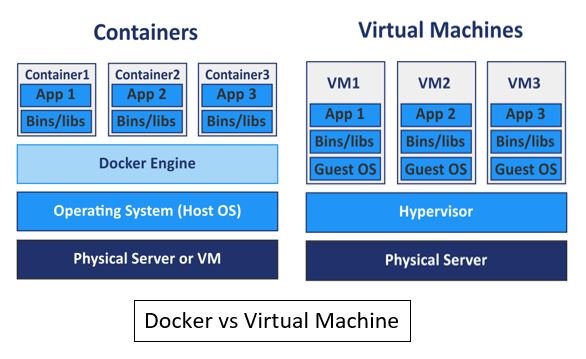Dear friends, today we will discuss about Docker vs Virtual Machine. So let’s start and see what are the differences between Docker vs Virtual Machine.
How is Docker different from a Virtual Machine?
Overview:-
Docker: – Only one layer between your real CPU and your web application. More powerful and better cloning/mirroring if you must only run your web application for virtualizing those, I recommend it.
While: –
Virtual Machine: – Three virtual layers must run for allowing your app run if you want server virtualization, but if you want only run a web application is not the best solution.
Docker vs Virtual Machine
Docker initially utilized Linux Containers (LXC), however later changed to runC (in the past known as libcontainer), which runs in a similar working framework as its host. This permits it to share a great deal of the host working framework assets. Additionally, it utilizes a layered filesystem (AuFS) and oversees organizing.
AuFS is a layered document framework, so you can have a perused just part and a composed part that are combined. One could have the normal pieces of the working framework as read-just (and shared among the entirety of your compartments) and afterwards give every holder its mount for composing.

In this way, suppose you have a 1 GB compartment picture; if you needed to utilize a full VM, you would need to have 1 GB x number of VMs you need. With Docker and AuFS you can share the greater part of the 1 GB between all the holders and on the off chance that you have 1000 compartments you despite everything may just have a little more than 1 GB of room for the compartments OS (expecting they are altogether running a similar OS picture).
A full virtualized framework gets its arrangement of assets distributed to it and does negligible sharing. You get more separation; however, it is a lot heavier (requires more assets). With Docker, you get less seclusion, however, the compartments are lightweight (require fewer assets). So you could without much of a stretch run a large number of holders on a host, and it won’t squint. Have a go at doing that with Xen, and except if you have a huge host, I don’t think it is conceivable.
A full virtualized framework typically takes minutes to begin, while Docker/LXC/runC holders take seconds, and regularly even not exactly a second.
For more about Docker vs Virtual Machine you can Click-Here
There are upsides and downsides to each kind of virtualized framework. If you need full detachment with ensured assets, a full VM is the best approach. On the off chance that you simply need to confine forms from one another and need to run a huge amount of them on a sensibly estimated have, at that point Docker/LXC/runC is by all accounts the best approach.
For more data, look at this arrangement of blog entries which work admirably of clarifying how LXC functions.
Deploying software to a Docker image or a consistent production environment
Conveying a reliable creation condition is quite difficult. Regardless of whether use instruments like Chef and Puppet, there are consistently OS refreshes and different things that change among hosts and conditions.
Docker enables you to depiction the OS into a common picture and makes it simple to convey on another Docker have. Locally, dev, QA, push, and so forth: no different picture. Sure, you can do this with different apparatuses, however not so effectively or quick.
You can also check this below link
How to Install Docker and manage container in CentOS 7
This is incredible for testing; suppose you have a huge number of tests that need to interface with a database and each test needs a flawless duplicate of the database and will make changes to the information. The exemplary way to deal with this is to reset the database after each test either with custom code or with instruments like Flyway – this can be very tedious and implies that tests must be run sequentially. Be that as it may, with Docker, you could take a picture of your database and run up one case for each test, and afterward run all the tests in equal since you realize they will all be running against a similar preview of the database. Since the tests are running in equal and Docker compartments, they could run all on a similar box simultaneously and should complete a lot quicker. Take a stab at doing that with a full VM.
Notion of snapshot-ting the Operating System
All the things considered; we should check whether I can clarify. You start with a base picture, and afterwards roll out your improvements, and submit those progressions utilizing docker, and it makes a picture. This picture contains just the distinctions from the base. At the point when you need to run your picture, you likewise need the base, and it layers your picture on the base utilizing a layered record framework: as referenced above, Docker utilizes AuFS. AuFS blends the various layers and you get what you need; you simply need to run it. You can continue including an ever-increasing number of pictures (layers) and it will keep on just spare the diffs. Since Docker regularly expands on instant pictures from a vault, you once in a while need to “depiction” the entire OS yourself.
Simply want to say your article is as surprising. The clearness in your post is simply excellent and i could assume you are an expert on this subject. Well with your permission let me to grab your feed to keep updated with forthcoming post. Thanks a million and please continue the rewarding work.
This is a very good tips especially to those new to blogosphere, brief and accurate information… Thanks for sharing this one. A must read article.